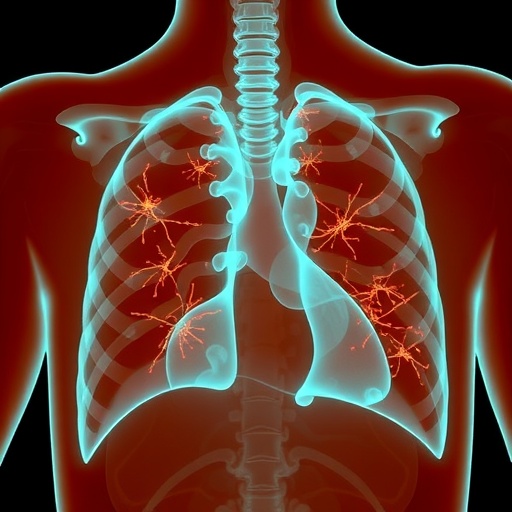In an age where artificial intelligence continues to redefine the landscape of medical diagnostics, recent advancements have showcased the remarkable potential of deep learning techniques, particularly in the early detection of pneumonia through chest X-ray images. A groundbreaking study by Doreen, Mwangi, and Muriithi explores the efficacy of few-shot learning strategies harnessed through Siamese networks, matched with transfer learning methodologies. This innovative approach promises to generate significant enhancements in medical imaging applications, especially in resource-constrained environments where data scarcity may hinder traditional training models.
The traditional approach to training deep learning models in medical imaging typically requires vast amounts of labeled data. However, in the context of pneumonia detection, obtaining high-quality labeled datasets can be challenging and time-consuming. The proposed research effectively addresses this limitation by employing a few-shot learning paradigm, enabling the model to learn from a limited number of examples and generalize to new, unseen data. This capability is particularly essential when dealing with rare cases or conditions that may not be adequately represented in larger datasets.
Central to the methodology employed in this study is the Siamese network architecture. This unique architecture is designed to measure similarity between two input samples, allowing for effective comparison even in scenarios where data is scarce. By utilizing this framework, the model can correctly identify pneumonia in chest X-ray images, improving sensitivity and specificity compared to traditional methods. This is achieved through the dual-input nature of the Siamese network, which processes pairs of images to ascertain their similarity based on learned features.
Moreover, the integration of transfer learning is pivotal to the study’s success. By leveraging pre-trained models that have been fine-tuned on a broader dataset, the researchers can take advantage of learned features that are generalizable across tasks. This significantly reduces the training time and resource expenditure typically associated with training a model from scratch. The study delineates how transfer learning can effectively boost the model’s performance when faced with limited data, allowing for rapid development cycles and practical real-world applications in clinical settings.
One of the standout features of this study is its commitment to ensuring that the model remains robust in various environmental conditions. X-ray imaging can be impacted by numerous factors including variations in machine settings, patient positioning, and noise. The researchers incorporated various data augmentation techniques to mitigate these issues effectively. By artificially generating diverse training examples through rotation, scaling, and flipping, the model becomes more resilient to real-world variabilities, thereby enhancing its diagnostic precision in clinical practice.
The model’s evaluation was carried out on a comprehensive benchmark of chest X-ray images that encompassed both healthy and pneumonia-affected patients. The meticulous selection of this dataset allowed for a rigorous assessment of the model’s performance metrics, including accuracy, precision, recall, and F1 scores. Preliminary results demonstrated a significant increase in detection rates, underscoring the potential of few-shot learning paradigms integrated with advanced neural architectures in revolutionizing the diagnostic processes within healthcare.
The implications of this research extend beyond mere technology; they provide a strategic blueprint aimed at addressing healthcare disparities, particularly in low-resource settings. Regions where access to trained radiologists is limited can particularly benefit from automated diagnostic tools capable of efficiently identifying pneumonia from X-rays. In this context, the anxiety associated with delayed diagnoses can be alleviated, subsequently improving patient outcomes and survival rates.
Furthermore, the study acknowledges the broader context within which such AI-driven healthcare solutions must be deployed. Concerns regarding ethical implications, data privacy, and the need for transparency in AI decision-making processes are paramount. The authors advocate for a collaborative effort between AI developers, medical professionals, and regulatory bodies to ensure that these technologies are implemented responsibly and equitably.
As the research community continues to expand on these foundational insights, further exploration into the optimization of Siamese networks, enhanced few-shot learning techniques, and emerging transfer learning strategies will be paramount. This ongoing trajectory signifies a shift toward the integration of AI at the forefront of clinical decision-making processes, propelling the field toward a future characterized by enhanced diagnostic accuracy and patient-centered care.
The crucial intersection of technology and healthcare illustrates how innovative solutions can emerge in the face of challenges. This research symbolizes a significant leap in leveraging deep learning for improved medical outcomes, with the potential to inform future studies aimed at tackling other critical medical conditions. By fostering a dialogue between technology and medicine, the aspiration for achieving enhanced healthcare delivery becomes an attainable reality, ultimately improving the quality of life for countless individuals around the globe.
In conclusion, the study by Doreen, Mwangi, and Muriithi represents a noteworthy advancement in the realm of pneumonia detection using state-of-the-art AI techniques. The strategic combination of few-shot learning, Siamese networks, and transfer learning mechanisms showcases the untapped potential that lies within the convergence of technology and medical imaging. As the healthcare sector grapples with ever-growing demands, innovative solutions such as these will play a pivotal role in shaping the future of medical diagnosis, empowering practitioners and ensuring timely interventions for patients in need.
Subject of Research: Pneumonia Detection using Few-shot Learning and Siamese Networks
Article Title: Few-shot pneumonia detection using Siamese networks and transfer learning on chest X-ray images.
Article References:
Doreen, A., Mwangi, W. & Muriithi, P. Few-shot pneumonia detection using Siamese networks and transfer learning on chest X-ray images.
Discov Artif Intell 5, 269 (2025). https://doi.org/10.1007/s44163-025-00468-6
Image Credits: AI Generated
DOI: 10.1007/s44163-025-00468-6
Keywords: pneumonia detection, few-shot learning, Siamese networks, transfer learning, chest X-ray images, medical imaging, artificial intelligence, healthcare technology.
Tags: AI-driven healthcare solutionsartificial intelligence in chest X-ray analysischallenges in medical imaging datasetsdeep learning advancements in diagnosticsenhancing diagnostic accuracy with AIfew-shot learning in healthcareimproving pneumonia detection accuracyinnovative techniques for rare diseasespneumonia detection using deep learningresource-constrained medical environmentsSiamese networks for medical imagingtransfer learning for pneumonia diagnosis





